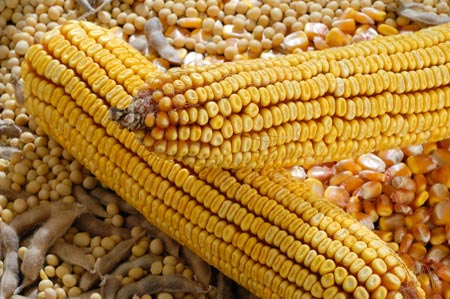 (Agriculture.com) – U.S. farmers will raise a 10.7-billion-bushel corn crop this year, down a touch from last month’s estimate and 13% lower than last year’s production, according to Thursday’s monthly USDA Crop Production report.
(Agriculture.com) – U.S. farmers will raise a 10.7-billion-bushel corn crop this year, down a touch from last month’s estimate and 13% lower than last year’s production, according to Thursday’s monthly USDA Crop Production report.
Soybean production’s a different story; this year, farmers will raise 2.86 billion bushels, USDA said Thursday. That’s up 9% from last month’s estimate and, though down 8% from 2011, reflecting possibly slightly better growing conditions for the soybean crop later on during the growing season.
Also in its monthly World Agricultural Supply and Demand Estimates (WASDE) report on Thursday, USDA lowered corn ending stocks by 114 million bushels, settling at 619 million bushels. That’s based on a projected national average corn yield of 122 bushels/acre, down only slightly from last month’s guess.
“Lower yields in Illinois are only partly offset by increases for Minnesota and North Dakota,” according to Thursday’s WASDE report.
Grain prices responded to Thursday’s data by shooting higher in early trading. December corn climbed 22 1/4 cents higher to $7.59 per bushel, while November soybeans jumped 23 3/4 cents higher to $15.47. December wheat moved 13 cents higher to $8.82 3/4.
The government’s new price projections for soybeans heading into winter is $14.25 to $16.25 per bushel, down $0.75/bushel from previous estimates. The corn range also fell slightly, losing $0.10/bushel off both bottom and top ends of the range, $7.10 to $8.50/bushel “based on early season cash and futures prices and prices available for forward delivery through early 2013,” according to USDA.
Those corn numbers are about right, but there’s more potential for higher prices in the soybean trade, says Don Roose, grain broker and market analyst with U.S. Commodities in West Des Moines, Iowa. The soybean range will likely be closer to $15 to $17/bushel based on big supplies, but big demand, too.
“Ending stocks are still tight,” he says. “There are no signs of rationing here, so the market goes up.”
Thursday’s numbers will likely have influence on the marketplace for some time, Roose says. There are still signs of sectors like livestock feed “having trouble rationing,” so the numbers wil likely shake off the harvest pressure of the last couple of weeks and keep things in more positive territory moving ahead.
“Harvest pressure was weighing on the market, and we didn’t have any signs of rationing yet, so the government made the decision here and said we have a big enough supply that we don’t have to ration,” Roose says. “But, you have to keep prices high enough that you are going to ration to a certain degree. Do we have to make new highs? No. Does it have to press prices down? No. We’ll see a big, broad trading range.”
Farmers agree on the potential for upside in prices moving forward, just not quite on how much those prices will move; they’ll have to move higher to ration current supplies of both corn and soybeans, the consumption of which many see as not slowing down much at all based on current prices. But, how much?




